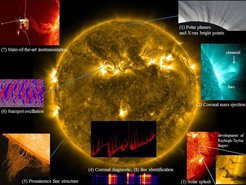
Coronal Spectroscopy and Imaging
Our research focusses on ultraviolet imaging and spectroscopy techniques, targeting at solar coronal features with a variety of scientific topics and methods that include:
- morphology and dynamics of coronal holes, spicules, sunspots, prominences/filaments, plumes
- coronal heating, energy transport
- flows, jets, flares, transient events; solar wind acceleration
- waves, oscillations
- density and temperature diagnostic, abundances
- ir/radiance measurements, line identification

The Sun seen in EUV emission is the focus of the CSI group's main research topic. Typical examples representing our work are shown here.
(1) Bright plumes that stream almost radially out of the polar coronal holes often have X-ray bright points near their footpoints. The connection between the two is not fully understood.
(2) A plasmoid lifting off at CME onset, triggered by a flare.
(3) During the spectacular eruption on 7 July 2011, material falling back onto the Sun is seen in absorption in the AIA-171 channel.
(4, 8) Fundamental diagnostic tools and a good knowledge of the solar spectrum in the wavelength range from 10 nm to 300 nm is the basis of our research.
(5) Solar prominences, observed at highest possible resolution, show the essential role of the magnetic field in driving flows and eruptions.
(6) Doppler image of a sunspot in a line formed in the transition region (N V 123.8 nm) reveals coherent oscillation across the spot with an amplitude of 8 km/s.
(7) Our group also develops, designs and operates the instruments needed to complete such observations.
The group's substantial involvement in the development and operation of space-based far and extreme ultraviolet solar telescopes has naturally led to a broad range of studies aiming at unravelling the underlying processes in the solar chromosphere, transition region and corona. The upper solar atmosphere is best - but not exclusively - observed in these wavelength ranges that are not accessible from the ground. Our research aims to constrain models that describe coronal dynamics on all scales, from the small-scale processes that drive the solar wind to large-scale flare and CME eruptions. The group's research complements the more theoretically orientated Coronal Dynamics and Plasma Simulation groups. This close collaboration between theory and observation is vital for our contribution to the development of ideas to push the limits of today’s technology to build the next-generation solar spectrometers and cameras.












